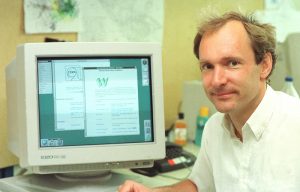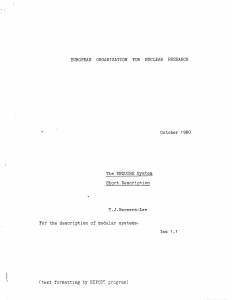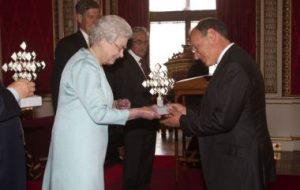The World Wide Web was invented by Sir Timothy John Berners-Lee, a british computer scientist born in London in 1955. He can be considered the “father of internet era” as he created an information system which radically changed the way people live in the contemporary civilized societies.

Image source: https://www.flickr.com/photos/itupictures/16662336315
How everything started?
The story behind the invention of the internet began in 1989 when Berners-Lee used to work as a software engineer at the European Laboratory for Particle Physics, also known as CERN, in Geneva (Switzerland). CERN was the focal point for a huge community of scientists from many countries. Although they used to spend time on the CERN site, scientists were usually working at universities and national laboratories in their home countries and among them grew the necessity to find a quick way to exchange information.

Image source: https://search.creativecommons.org/photos/a9d73bc4-a35b-4b87-9350-7fe2915fe9d9
The ENQUIRE Software project
The development of the World Wide Web was encouraged by an hypertext computer program, named ENQUIRE, which Berners-Lee created in 1980 and considered a “memory substitute” for his personal use to help him remember connections between various people and projects. Despite this, the ENQUIRE program wasn’t accessible to everybody and needed to keep information constantly up to date. There was the necessity for people to be able to create cards independently from the others and to link to the other ones without updating the linked card. Also, the system wasn’t powerful enough to handle many connections to the database.
“In those days, there was different information on different computers, but you had to log on to different computers to get at it. Also, sometimes you had to learn a different program on each computer. Often it was just easier to go and ask people when they were having coffee…” -Tim Berners-Lee

Image source: https://www.w3.org/History/1980/Enquire/COVER.GIF
https://www.w3.org/History/1980/Enquire/manual/
The development of the WWW
Learning from these issues, Berners-Lee thought about a global information space where information stored on computers was linked everywhere and available for everybody. Using this kind of networking scheme would have meant not needing a centralized system, so the new network wouldn’t have trouble with scalability and could have grown to infinity. Tim Berners- Lee then built a coding system that would be easy to learn and useful to build web pages, called HyperText Mark-up Language (HTML). It has become the most wildely used language to create web pages and sites. He later created a new set of protocols that allowed these HTML documents to be connected across the Internet, called HyperText Transfer Protocol (HTTP). After that, he coded the first web browser, a client program which allowed users around the world to access web pages on the internet. He named it “WorldWideWeb”, published in 1991 with the first web server software called “info.cern.ch.”.

Image source: https://cds.cern.ch/images/OPEN-PHO-CCC-2019-001-1
The impact on the society
Being not recognized for his inventions and efforts by CERN, Berners-Lee turned to the Internet community posting notices to several newsgroup, making users enthusiast and growing at exponential rates. Since that, the world of mass media and the way people interface changed forever, and since the Internet was brought online, many social networking sites have deeply changed how people, businesses and organizations communicate. Berners-Lee has been widely honored for his inventions, winning important international prizes as the Queen Elizabeth Prize for Engineering in 2013 and the Turning Award in 2016.

Image sourge: https://www.zimbio.com/photos/Tim+Berners-Lee/Queen+Elizabeth+II+Hosts+Reception+London/FV9NvpK-w6R
Info source:
https://home.cern/science/computing/birth-web/short-history-web
https://tecnologia.libero.it/tim-berners-lee-linventore-del-world-wide-web-10791
http:// https://www.ibiblio.org/pioneers/lee.html
https://www.internet-guide.co.uk/ENQUIRE.html
https://en.wikipedia.org/wiki/ENQUIRE
https://www.ukessays.com/essays/media/tim-berners-lee-the-inventor-of-the-internet-media-essay.php
